How To Change The Lense On A Canon Sx-10 Camera
If you are wondering about how to calibrate lenses, this commodity has detailed explanations and dissimilar methods of AF fine-tuning. Due to the nature of the phase detect autofocus arrangement that is nowadays on all SLR cameras, both cameras and lenses must be properly calibrated by manufacturers in order to yield sharp images. Various factors such as manufacturer defects, sample variation, insufficient quality balls testing/tuning and improper shipping and handling can all negatively impact autofocus precision. A lot of photographers become frustrated after spending thousands of dollars on camera equipment and not existence able to get anything in focus. After receiving a number of emails from our readers requesting help on how to calibrate lenses, I decided to write this tutorial on means to properly fine-tune focus on cameras and lenses. Lens calibration is a complex topic for many, so my goal is to make this guide as uncomplicated every bit possible so that you could manage the process by yourself, while fully understanding the unabridged process. In addition, I strongly recommend following these tips every time you purchase a photographic camera or a lens in lodge to identify and address whatever potential focusing issues. But I have to warn you – this article is NOT for beginners. If y'all just got your first DSLR, you might get very quickly frustrated with the scale process.
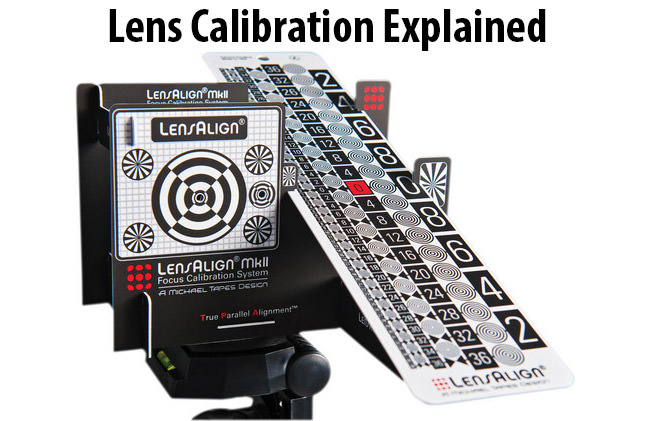
Table of Contents
ane) Why Calibrate?
Why is there a need to calibrate lenses? With the release of new, loftier-resolution cameras like Nikon D800, it seems like calibration is becoming an important and hot topic. Why is that? Every bit I have explained in a number of my photography articles and reviews, while the increase of megapixels in our cameras has a number of benefits (encounter benefits of high-resolution cameras), information technology tin can also expose potential focus bug. A slight focus issue might not be as noticeable on a ten-12 MP sensor, simply will be much more than noticeable on a 25+ MP sensor (bold both sensors are of the same size). Especially when viewed at 100%, which is what we, photographers, unfortunately, like to do too much. Hence, the need for a properly calibrated photographic camera setup today is bigger than ever.
While landscape and architectural photographers might non care almost focus bug (since they photograph at very small apertures that hide small focus issues), portrait, event and wildlife photographers are typically much more worried about focusing issues. I personally like to photo people wide open with my lenses, which tin be a claiming for obtaining perfect focus on my subjects. How frustrated would you exist, if yous focus on someone's middle and you go their nose or ears in focus instead? I am sure you lot would not want to accept such issues, which is why I encourage you to examination your gear and fine tune it for optimal results.
2) Camera vs Lens Calibration
The procedure of calibration involves going through a specific camera setting that allows fine tuning autofocus performance of lenses, which means that nosotros will Non be changing anything on the actual lens. Physical calibration of lenses should only exist performed by manufacturers, since lenses take to be disassembled, tuned and reassembled. I would never recommend to try doing this yourself at habitation, unless you really know what you are doing and you lot are OK with voiding the warranty and potentially damaging your lens.
three) How Scale Works
As I pointed out in the phase detection autofocus organisation and how to exam your DSLR for autofocus issues articles, the source of autofocus problems could be an improperly calibrated camera, a lens or both. The procedure highlighted beneath can potentially address all three scenarios, depending on how desperately misaligned the whole setup is (more on this later on).
The manner scale works, is the photographic camera has a setting, which allows compensating for either back-focus (when focus is shifted behind the focused area) or forepart-focus (when focus is shifted in front of the focused area). This compensation can exist performed in small incremental steps (typically from 0 to -twenty and +20 in steps of ane), which allows for precise fine tuning of the autofocus system. Negative numbers recoup for back focus, while positive numbers compensate for forepart focus problems. To put it differently, dialing a negative "-" number will move the focused bespeak closer to the camera, while dialing a positive "+" number will motility the focused indicate away from the camera. And then what happens when you dial -v, for case? The camera tells the lens something like this: "aim at where you would ordinarily focus, except slightly movement the focused bespeak closer to the photographic camera". In essence, this would be needed when your camera and lens combination constantly back-focuses.
An important fact to keep in mind, is that calibration is camera and lens specific, which means that if you lot accept multiple cameras and lenses, you take to fine tune autofocus on each camera, for each lens y'all own (unless you lot have a camera that constantly front end-focuses or back-focuses by the same amount with all lenses, in which case you might need to compensate simply for the camera itself). In improver, you might need to periodically re-calibrate your camera gear (more on this below).
iv) Calibration Naming Convention
Unfortunately, equally you lot may already know, there is no standard way of naming things in the camera world. All manufacturers have their own naming conventions, partly considering information technology might be the technology they adult and patented themselves, and partly because they just want to exist different. For example, Nikon calls its lens stabilization technology "Vibration Reduction" (VR), while Canon calls information technology "Prototype Stabilization" (IS) and fifty-fifty Tamron, being a third party lens manufacturer for both Nikon and Canon, chose a different name for the same technology – "Vibration Compensation" (VC). All three practise the same affair and yet they are called differently. The same thing with lens calibration – it turns out the verbiage for the same matter is different across manufacturers:
- Nikon – AF Fine Tune
- Canon – AF Microadjustment
- Sony – AF Micro Adjustment
- Pentax – AF Adjustment
- Olympus – AF Focus Arrange
Then if you are looking for this feature in your camera, keep the above naming conventions in mind.
five) Calibration Feature Availability
The bad news is that this very important scale feature is only available on higher-end DSLRs, because all manufacturers consider information technology to be an "advanced" feature. Equally of today, all entry-level, upper entry-level and some semi-professional person DSLRs do not have this capability. Here is a list of current Nikon DSLRs that take the "AF Fine Melody" characteristic (as of 10/08/2012):
- Nikon D7000
- Nikon D300s
- Nikon D600
- Nikon D800/800E
- Nikon D4
I will not bother listing older/discontinued cameras and cameras past other manufacturers, because the list would exist too long. You can notice out if your photographic camera has this feature in your camera manual.
6) Calibrating Prime number vs Zoom Lenses
While I recommend calibrating both prime and zoom lenses, there are a few factors to consider. Most prime lenses, especially above the "standard" range of 50mm accept very shallow depth of field at close distances. They are typically my first candidates for calibration, since a slight focus variation can exist rather frustrating for me when I work in the field. Zoom lenses, on the other mitt, are typically much more challenging, considering in that location is typically a zoom and discontinuity range to work with. For instance, a superzoom lens similar Nikon 28-300mm f/3.5-5.6G VR can go from 28mm to 300mm and its discontinuity changes from f/3.5 on the short terminate to f/five.6 on the long end. Considering calibration can only exist done for a certain focal length (on some lenses with a severe instance of focus shift, I would recommend to even pick a single discontinuity to fine tune), which focal length would one pick to fine tune? You would have to either go with a focal length somewhere in the middle of the zoom range, or pick the most normally used focal length to fine tune. For example, when I fine tune my Nikon 200-400mm f/4G VR lens, I e'er pick 400mm at f/4 for fine tuning, because that'southward the focal length and aperture I use nigh of the time. Whereas, for a prime lens like Nikon 85mm f/1.8G, I would fine tune at f/1.8, since that'due south the aperture I typically use the virtually on that lens. More than on this beneath.
seven) Calibration Tools
There are a number of free and commercial tools for calibrating / fine tuning lenses. I have tried a number of different methods and I take identified which ones piece of work and which ones are unreliable. One of the gratis/DYI methods involves printing a bunch of lines on a piece of paper, then setting up your camera at a 45 degree angle and taking pictures. I started out with this method about 4 years ago and rapidly found it to be very unreliable. With high resolution cameras similar D800, using this method tin can yield unpredictable results, since fine tuning has to be very precise to become authentic results. Some other gratuitous/DYI method is to use your monitor screen with a exam chart paradigm, which again tin be problematic for proper testing. The second method is to get a commercial tool like LensAlign by Michael Tapes Pattern, which is what I have been doing for the final 3+ years and notice information technology to be much more reliable and precise than the costless method. The third method is to use an automated/semi automated software scale tool that can relieve you time and possibly yield better results. Here is a quick summary with pros and cons of each method:
- DYI Method – Pros: Free, can work if washed right. Cons: Precision/accuracy problems, requires a lot of fourth dimension to setup correctly, does not work well with high-resolution cameras.
- LensAlign – Pros: Works with any camera/lens combination, can be very precise. Cons: Costs money, requires time for manual adjustments and fine tuning.
- Calibration Software – Pros: Automated/semi automated scale process, high precision, saves time. Cons: Costly and just works well with supported cameras.
8) Calibration Steps
I recommend to take a number of steps for proper and accurate camera calibration. Starting time, you lot should place if there is a focus problem. Second, you should try calibrating your camera/lens. The last step is to verify if your calibrated setup works reliably at unlike distances.
eight.1) Identify Focus Problems
If you are an avant-garde DSLR user, you will typically know right away when there is a focus problem. However, in many cases it is the end-user fault or an issue with camera technique that yields soft images, so I always recommend to use proper ways to identify focus problems. My recommended approach to identify focus issues is highlighted in my "how to test your DSLR for autofocus issues" article I wrote a while ago. While this approach works quite well, information technology does non bespeak out if you have front or back focus issues. That's where a tool like LensAlign can come in handy – you will not only know right abroad if there is a problem, but you lot volition also determine if the focus problem is related to back-focus or front end-focus.
8.ii) LensAlign: Manual Calibration
The procedure of manual lens calibration using LensAlign is pretty straightforward, once you empathise what to do and do it a few times:
- Yous should be in an surround where there is a lot of ambient low-cal, and so preferably, do this outdoors in daytime. If that's non an selection, you will have to setup powerful lights to properly expose the LensAlign tool, since a single light seedling in your room will not be sufficient for authentic focus (when doing this indoors, I take four defended 100W lamps that I point right at LensAlign).
- Ready the LensAlign tool on a calorie-free stand up or a apartment surface, and so mount your camera on a tripod and properly level it. Thanks to the patented leveling method that Michael Tapes adult, leveling your camera is easy – you simply marshal the ruddy dots on the back of LensAlign with the holes on the front, so that it looks like this:
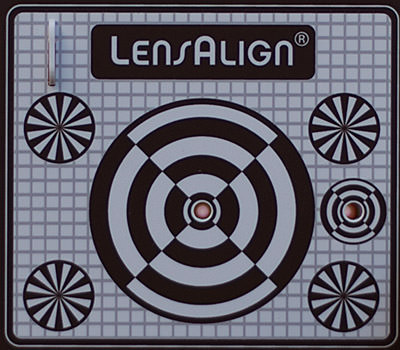
- Identify your camera at a certain distance, depending on the focal length of the lens. Michael Tapes has a neat "Distance Tool" on his website that you lot can use to calculate the proper altitude. For instance, for the Nikon 50mm f/1.4G lens, the recommended distance between LensAlign and the photographic camera is roughly 4 anxiety. Personally, I do non rely on any distance tools, considering I roughly set it upwardly to what my typical focusing distance is when photographing subjects. Merely if yous don't know where to start, the altitude tool tin can be quite helpful.
- Set the AF aligning on your camera to "0" (Setup Menu->AF Fine Tune on Nikon DSLRs) or just turn it off. We will need to start from zero initially and get from in that location.
- Focus on the circular pattern on the left side of the ruler with your centre focus betoken looking through the viewfinder and take a serial of pictures. In betwixt each exposure, you should rack the focus ring, and then that everything looks blurry before yous start. That manner, you force the AF system to reacquire focus each time.
- Do this at least 3 times, so clarify each image on your camera (you can take it to your computer for assay, merely it takes a long time to get dorsum and forth, then I prefer to do information technology on my camera instead). If yous choose to exercise it on your camera and yous have a Nikon DSLR, hither is a quick tip – zoom in to 100%, then rotate the rear dial – information technology will spring from i picture to another, still keeping the zoom level. Hither is a sample image that I got with a badly calibrated lens:

As you can see, there is a rather severe problem with autofocus here – the left side of the LensAlign tool is out of focus and by looking at the right side, yous can tell that my setup is backfocusing quite a scrap. Instead of showing 0 in focus, it is far off somewhere at 12 in the middle section of the ruler.
- Next, you lot have to plough AF Fine Tune / Microadjustment on and prepare a value to compensate for the focus problem. Since it is a backfocus situation in this case, I know that I have to recoup by dialing a negative number. I always offset off with an extreme number at -xx or +20, to run across how much I demand to come down. So in this case, I set it to -xx, which turned out to be too much and my focus moved to the front (front end focus). Generally, I decrease the number in increments of 5 get-go, then do additional fine tuning if necessary. For this lens to land perfectly in focus, I had to punch -12.
- The painful part of this process is that at that place is a lot of going back and forth, since you accept to rack the focus ring 3 or more times each time you alter the AF aligning value. The reason why you want to do this, is because Phase Detection Autofocus is often not consistently authentic if you merely rely on one exposure. Here is an example of a properly tuned setup using the Nikon 85mm f/1.4G lens (no sharpening was added to the image):
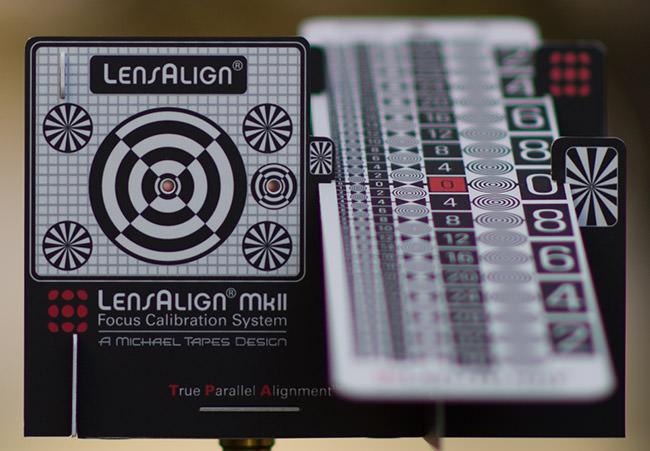
As you tin see, the left side of the LensAlign tool is in perfect focus and the ruler on the correct side confirms this – the focus bespeak is correct number 0.
- One time you get consistently good results using a detail AF aligning setting, have your camera for a real exam. Accept some pictures outdoors at different distances and come across if things await skilful. If they don't, then go dorsum and endeavor the aforementioned exam at a different distance and see what you get. If yous notice that you have to punch vastly different numbers at different distances and focal lengths, and then you might be better off by turning AF Fine Tune off completely. See some of the boosted notes on calibration below.
I am aware of the fact that there are other tools similar to LensAlign. Nevertheless, Michael Tapes was the original inventor of this tool, so I consider all other lookalikes equally "knockoffs" of LensAlign. None of them have the born alignment tool, because Michael patented it. In addition, Michael operates a small business right hither in the US and our squad at Photography Life is all about supporting him instead of big corporations.
8.3) FoCal: Automated Calibration
The procedure with automated lens scale is a little different. Currently, Reikan FoCal seems to be the leader in automated calibration software, which not only performs automated/semi-automated scale (depending on what camera is used/supported), but likewise comes with pretty advanced reporting capabilities and testing of each individual focus point. The software became increasingly popular on Nikon cameras lately, thanks to the whole Nikon D800 Asymmetric Focus Fiasco, because it tin can conspicuously show which focus points are accurate and which ones are not, as shown in the below paradigm:
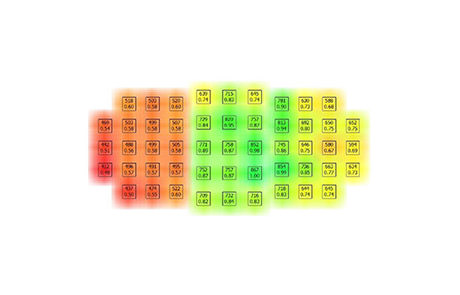
Here is the process of scale using FoCal Pro (the software package nosotros recommend):
- You will need a PC or a laptop (preferably, due to potential proximity issues) for the fully automated scale. PC/Mac requirements, forth with supported cameras are highlighted here. Connect your camera to your computer using the supplied USB cable, power it on and install camera drivers showtime (if necessary). Once drivers are installed and configured, install the FoCal software. Once everything is tested, turn the camera off and disconnect the cablevision (for now, until the setup is complete).
- Make sure that the camera is recognized by the software. Test and make sure that everything is operational.
- Once again, y'all should exist in an environment where at that place is a lot of ambience light, for autofocus to work properly. If that's not an option, you will take to setup powerful lights to properly expose the focus chart, since a single light bulb in your room will not be sufficient for accurate focus.
- Print out the PDF exam chart that comes with FoCal software. You can print it on a regular letter-size paper. A loftier-quality inkjet printer is recommended.
- Mountain the test nautical chart on a flat surface. A straight indoor wall will practice.
- Mount your camera on a tripod and place it at a certain distance right beyond from the chart, depending on the focal length of the lens. The developer recommends to aim for between nigh 25x – 50x the focal length of the lens in millimeters, so if yous are calibrating a 50mm lens, y'all should exam at effectually ane.25m to 2.5m. Make sure that the chart is parallel to your camera and that zip is titled. The software will automatically guide you on how to properly marshal/rotate the setup.
- Connect the USB cable to the camera and your PC/laptop. Start up live view and allow the software guide you lot on how to move/align the test target.
- In one case the software shows you a green checkmark, starting time the automated test procedure (Catechism DSLRs just). It will take a while for the camera to have pictures and adjust the focus. Hither is how the process looks like:
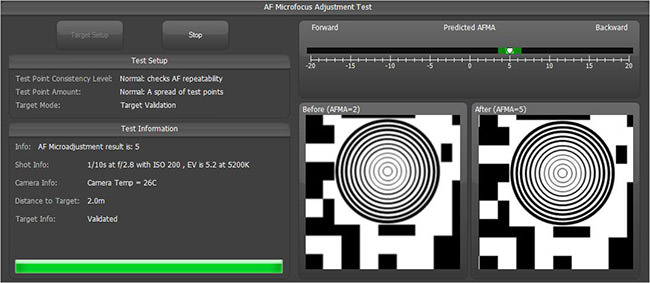
If you accept a Nikon DSLR, you will have to use the Transmission Setting Change (MSC) mode, where the software will tell you what to change on the photographic camera and y'all will have to dial the values manually (until Nikon DSLR back up becomes available in a time to come release), as shown in the following image:
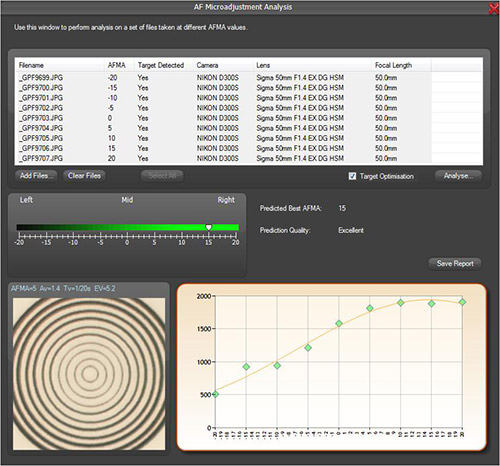
- The software will clarify each paradigm and tell you which AF adjustment value works all-time.
- Similar to the LensAlign procedure highlighted higher up, I strongly recommend to take your camera for a existent test after the calibration procedure. Exam information technology at different distances and come across if you are getting consistently good results or not.
The absurd thing near the FoCal Pro edition, is that information technology allows yous to also find out what aperture is the sharpest on your lens and as I accept already pointed out above, information technology can likewise analyze each focus indicate of your photographic camera for precision.
9) Calibration Altitude
One big catch with the calibration process, is that it may vary by distance. I accept done a number of tests to show examples of this behavior (will exist posted in a separate article afterward). What it means, is that if yous compensate your camera for a back-focus problem at a certain distance, if the altitude between the camera and the subject changes, the focus might be off again. For example, a 50mm f/1.4 lens at 4 feet might require a -5 adjustment. Moving the lens to 6 feet might crave a different adjustment, say -eight. Then taking the lens and focusing at infinity might crave no aligning. This happens due to a number of different factors. Commencement of all, phase detect sensors in DSLRs require a lot of light, which is the reason why all lenses focus broad open, no matter what aperture yous set the lens to. So a bunch of variables kick in right abroad – chosen discontinuity, focus shift, focus distance, etc. On top of that, fine adjustments at very close distances are much more granular than at longer distances. Well, the AF fine tuning system is not that smart to be able to cope with all these variables and therefore calibration values might have to exist different at various focal lengths, apertures and photographic camera to field of study distances. However, this varies by lenses. On some lenses, the divergence is very noticeable, while on other lenses differences are likewise minor to find.
10) AF Fine Tune Observations
I found out a couple of interesting things while studying AF calibration on various Nikon DSLRs (for uber geeks just!). When testing cameras with autofocus problems (with perfectly calibrated lenses), dialing a value for "AF Fine Tune" would often work for any distance, whether close or far. So if I had a camera that required -10 for every lens, which means a camera phase observe result, keeping AF Fine Tune at -x at all times would typically work corking at any aperture, distance and focal length. Yet, if a camera was perfectly calibrated and a lens had a focusing effect, then AF Fine Tune would not work and then well at various distances. The worst issues were when both a camera and a lens had problems – that's when trying to calibrate the setup could yield strange/inconsistent results. This is my observation, although more than in-depth testing would have to exist carried out to confirm this. Also, I exercise not know if other manufacturers take similar implementation of Nikon'due south AF Fine Melody and results might vary by brand.
This is not to say that I would rather have a camera with badly aligned AF sensor than a badly calibrated lens. In fact, it is the other style around. My camera bodies stay the same for several years, while I might use a number of dissimilar lenses on them. I would non desire to accept issues with all lenses out there, just because my camera is faulty. If the camera has a slight outcome, it would not carp me, since I could punch one setting for all lenses. But if it is annihilation farthermost (my D800E was actually bad and required -20 and higher to piece of work with my lenses), and so I volition surely either commutation the camera, or send information technology to manufacturer for tuning. That'south the reason why I like to find out what the source of the autofocus problems is. Is information technology the camera, is it the lens or both? Unfortunately, this i is tough to figure out for most people out at that place, because information technology requires at to the lowest degree one properly calibrated camera and lens. I have a number of lenses that piece of work perfectly fine on my Nikon D600, D700 and D3s camera bodies and I also know that these camera bodies are properly calibrated, because about lenses I mount on them do not crave whatever fine tuning. Knowing this, if I receive a faulty photographic camera, I know if there is a problem right away. The same goes for lenses…
11) The Usefulness/Uselessness of Camera Calibration
Another ascertainment that I have afterward a number of years working with cameras and lenses, is that camera calibration only works reliably well at small adjustments, when it is not extreme. A while ago, one of our readers asked me "how come we simply become -20 to +xx for AF Fine Tune, why doesn't Nikon allow much bigger values similar -50 to +50?". It was an interesting question that I could not answer at the time, because I did non have a camera/lens combination that required extreme calibration values. While testing various Nikon DSLRs during the last few years, I came across a couple of camera bodies and lenses that had severe back/front focus bug, where something similar -twenty adjustment had to be dialed during the scale process. In cases where a photographic camera body was at fault, the affect of an farthermost adjustment did non seem to be so bad (although it was still non very reliable), while when a lens was at mistake, dialing in a higher place -10 or +10 (peculiarly to a higher place ±15) yielded very inconsistent results. Hence, my determination is that if y'all discover that your camera/lens setup requires high adjustment values (negative or positive), you might not want to mess with the whole affair and send your gear to the manufacturer for proper tuning instead. That'south probably why none of the current DSLR manufacturers allow scale for college values than twenty.
12) Scale Tolerance
And so, what tolerance levels for calibration are acceptable? For me, anything beneath ±10 for a camera or lens is acceptable. Ideally, I want to stay in the ±5 range, but if fine tuning takes care of the problem, I do non bother sending my gear to manufacturer for tuning. If a new camera I purchase requires -5 to -x with all of my lenses, I will just have intendance of information technology with AF Fine Tune. If it is anything above that, I will send it to Nikon for tuning. The same affair goes for lenses.
13) Scale is a Continuous Process
Whether you like it or not, autofocus precision of your cameras and lenses can change overtime. There are many unlike factors that could influence precision – everything from drastic changes in temperatures, to concrete abuse and normal clothing and tear. Some people take it very seriously and perform scale every bit often as a few times per month. I personally do information technology a couple of times before and during the wedding season, to make certain that the gear works as expected. The goal of my tests is to make sure that the gear I use operates normally. If I see any drastic changes in autofocus behavior and AF adjustment does not piece of work consistently anymore, I contact Nikon and send my gear in for repair. Yes, this process is rather painful and can get costly, but it is worth it, because our clients get the very all-time quality work from usa.
xiv) Summary
As you can see from this article, calibration is a complex topic. Unfortunately, a number of photographers and online resource blindly recommend taking dissimilar approaches to lens calibration without fully understanding how autofocus system works, which leads to more frustration and unhappiness from terminate users. In my stance, it is important to know and understand all the details of the procedure, including possible outcomes earlier deciding to bear upon this feature. Despite all challenges, I still highly recommend to play with the AF adjustment feature on your photographic camera and learn how to properly calibrate your photographic camera gear. At the end of the 24-hour interval, you lot desire to get the best out of your equipment.
I apologize if the article is too long. Skillful luck and please let me know if you lot accept any questions in the comments section below.
Source: https://photographylife.com/how-to-calibrate-lenses
Posted by: silvasessood.blogspot.com






0 Response to "How To Change The Lense On A Canon Sx-10 Camera"
Post a Comment